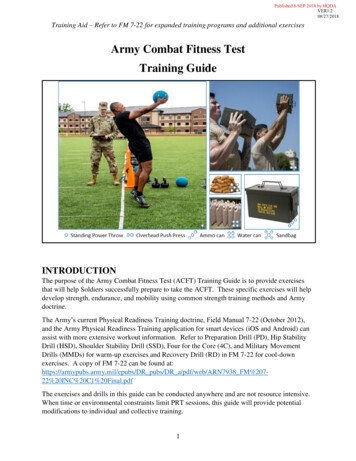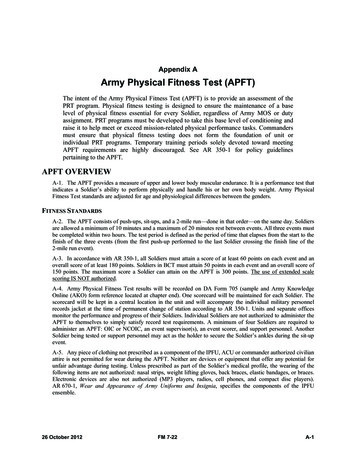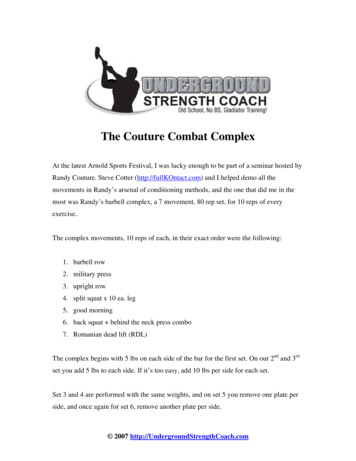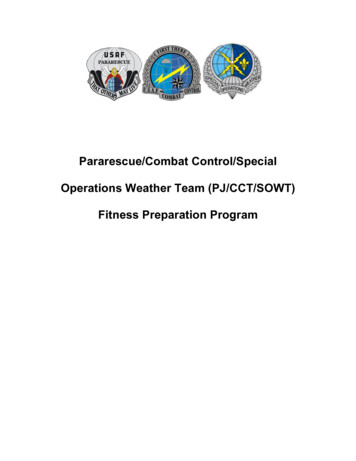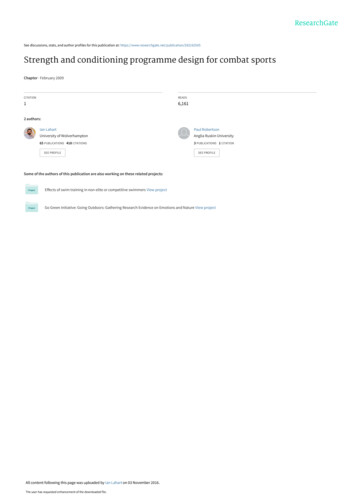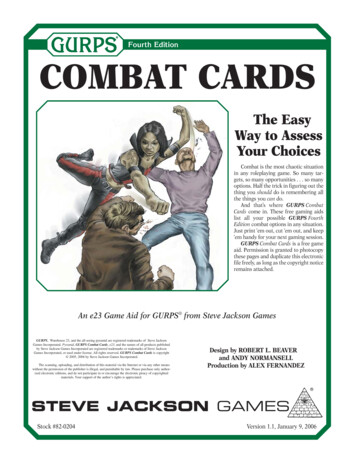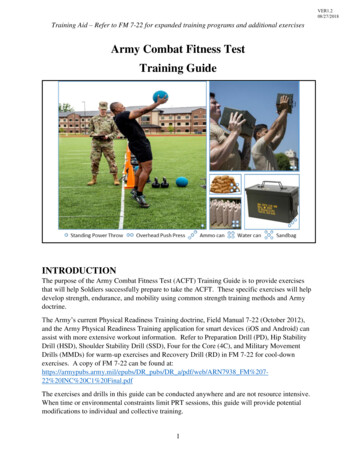
Transcription
VER1.208/27/2018Training Aid – Refer to FM 7-22 for expanded training programs and additional exercisesArmy Combat Fitness TestTraining GuideINTRODUCTIONThe purpose of the Army Combat Fitness Test (ACFT) Training Guide is to provide exercisesthat will help Soldiers successfully prepare to take the ACFT. These specific exercises will helpdevelop strength, endurance, and mobility using common strength training methods and Armydoctrine.The Army’s current Physical Readiness Training doctrine, Field Manual 7-22 (October 2012),and the Army Physical Readiness Training application for smart devices (iOS and Android) canassist with more extensive workout information. Refer to Preparation Drill (PD), Hip StabilityDrill (HSD), Shoulder Stability Drill (SSD), Four for the Core (4C), and Military MovementDrills (MMDs) for warm-up exercises and Recovery Drill (RD) in FM 7-22 for cool-downexercises. A copy of FM 7-22 can be found at:https://armypubs.army.mil/epubs/DR pubs/DR a/pdf/web/ARN7938 FM%20722%20INC%20C1%20Final.pdfThe exercises and drills in this guide can be conducted anywhere and are not resource intensive.When time or environmental constraints limit PRT sessions, this guide will provide potentialmodifications to individual and collective training.1
Training Aid – Refer to FM 7-22 for expanded training programs and additional exercisesOVERVIEWTable 1: A Summary of the recommended garrison and field exercises and supportingdrills for each ACFT event. Alternate equipment options are listed for circumstanceswhere standardized training and testing equipment is not available.TopExercisesTop PRTDrillStandardEquipment3 RepetitionMaximumDeadlift1. Sumo Squat2. AlternateStaggered SquatJump3. ForwardLungeStandingPowerThrow1.Power Jump2. OverheadPush-Press3. Tuck JumpHand-ReleasePush-upStrength TrainingCircuit60lb trap bar andplatesConditioningDrill 310lbMedicine Ball10lb sand bagSlam ballKettlebellAlternateAmmo CansEquipment Duffle BagRucksack5 gallon watercansTow barsPVC pipeWooden handleSprintDragCarry1. StraightLeg Deadlift2. Bent OverRow3. 300MShuttle RunLeg Tuck2 Mile Run1. Bent LegRaise2. Leg Tuckand Twist3. AlternatingGrip Pull-upFour for theCoreKettlebellsGuerilla DrillClimbing Drill2Climbing Bar1. SprintIntervals(30:60s,60:120s)2. ReleaseRun3. HillRepeats10 x 60:120sAmmo CansTow barIOTV40lb Duffle40lbRucksack1. SupineChest Press2. 8-CountPush-up3. InclineBench4. Quadraplex2x40lb KBs90lb sled90lbSKEDCO90lb Litter90lb LogTires2Pull-up barSuspensiontrainerStretch Cords2MR RouteTreadmill(to simulatethe drills andexerciseslisted above.)
Training Aid – Refer to FM 7-22 for expanded training programs and additional exercisesEVENT TRAINING3 Repetition Maximum DeadliftTOP THREE EXERCISESExercise 1: Sumo Squat (from Strength Training Circuit (STC) Drill)Risk Mitigation: Soldiers should begin training with an empty straight bar or PVC pipe toperfect their squat technique (see check points below). A master fitness trainer can assist indeveloping proper form. Beginners should work for 2-4 weeks at loads of 40-50% of their bodyweight (ex: body weight 170lbs; lift weight 70-85lbs) or 25-50% of their 1 repetitionmaximum (1RM). Beginners should maintain a relatively constant weight and increaserepetitions with proper technique during a 2-4 week base phase.Purpose: This exercise develops strength, endurance and mobility of the trunk and lowerextremities.Equipment: Kettlebell, straight bar (45lbs), weight plates, collars, spotter.Starting Position: Straddle stance with the feet wider than the shoulders and the toes pointingoutward. Hold a single kettlebell or straight bar with both hands, in front of the body, using apronated grip (palms facing the body). Weight will be appropriate for the goal of the PRTsession.3
Training Aid – Refer to FM 7-22 for expanded training programs and additional exercisesExecution: Squat while leaning slightly forward from the waist with head in line with the spine.Move downward until the upper legs are at least parallel to the ground, pause and return to thestarting position.Exercise Prescription: 2-3 Sets of 12-15 reps using weight equal to 50-65% of 1RM.Figure 1: Sumo SquatCheck Points: Ensure feet are spread wider than shoulder width apart. Ensure knees are in line with the toes and heels remain on the floor. Ensure head and neck are in line with eyes facing forward. Avoid rounding of the shoulders and spine and avoid letting the knees collapse inward(knock-knee).4
Training Aid – Refer to FM 7-22 for expanded training programs and additional exercisesExercise 2: Alternate Staggered Squat Jump (from Conditioning Drill 3 (CD3))Risk Mitigation: Soldiers will perform a dynamic warm-up before starting this exercise. Amaster fitness trainer can assist in developing proper form. Beginners should start with 5repetitions in a limited range of movement. Beginners should increase repetitions with propertechnique to 10 repetitions across a 2-4 week base phase.Purpose: This exercise develops balance and explosive strength of the legs.Equipment: Level space.Starting Position: Staggered stance with the left leg back and arms at sides; the trunk isgenerally straight, but tilted slightly forward.Execution: Squat and touch the ground between the legs with the fingertips of the left hand.Jump forcefully into the air, switching legs in mid-air to land with the right leg back and arms atthe sides. Repeat the squat, touch and jump on the opposite side.Exercise Prescription: 1 Set of 5 to 10 repetitions.Figure 2: Alternate Staggered Squat JumpCheck Points: Do not allow the back to round; keep the head up and the eyes forward. Cadence is slow to allow for precision and adequate time to properly jump and land;however, each jump should be performed quickly and explosively. On each landing, the feet should be oriented to the front. The landing should be “soft” and proceed from the balls of the feet to the heels.5
Training Aid – Refer to FM 7-22 for expanded training programs and additional exercisesExercise 3: Forward Lunge (from Preparation Drill (PD))Risk Mitigation: Soldiers will perform a dynamic warm-up before starting this exercise. Amaster fitness trainer can assist in developing proper form. Beginners should start with 5repetitions in a limited range of movement. Beginners should increase repetitions with propertechnique to 10 repetitions across a 2-4 week base phase.Purpose: This exercise develops strength, endurance, balance and mobility of the legs and trunk.Equipment: Level space.Starting Position: Staggered stance.Execution: Step forward with the left leg as in the forward lunge as in the PD, allowing the leftknee to bend until the left thigh is parallel to the ground. Return to the starting position. Repeatwith the right leg. Return to the starting position. As skill improves and to add load, perform thesame movements with weight in each hand. More advanced Soldiers can increase exerciseoverload by adding kettlebells, water cans, sandbags, etc. to the Forward Lunge. Loads shouldprogress from light (5lbs) to moderate (10lbs) to heavy (20lbs) in each hand. Lean slightlyforward from the waist and bring the kettlebells to the left and right sides of the forward leg.Return to the starting position. Repeat with the right leg. Return to the starting position.Exercise Prescription: 1 to 3 sets of 5-10 reps.6
Training Aid – Refer to FM 7-22 for expanded training programs and additional exercisesFigure 3: Forward LungeCheck Points: Keep the forward heel flat on the ground and the rear heel up. Keep the forward knee directly over the ball of the foot. Push off vigorously with the forward leg to return to the starting position. Do not allow the forward knee to go beyond the forward toes or waiver from side to side.Do not jerk the trunk rearward to return to the starting position. Ensure feet are spread approximately shoulder width apart. Ensure knees are in line with the toes and heels remain on the floor. Ensure head and neck are in a neutral position with eyes facing forward. Avoid rounding of the spine and letting the knees collapse inward (knock-knee).7
Training Aid – Refer to FM 7-22 for expanded training programs and additional exercisesEVENT TRAININGStanding Power ThrowTOP THREE EXERCISESExercise 1: Power Jump (from Conditioning Drill 1 (CD1))Risk Mitigation: Soldiers will perform a dynamic warm-up before starting this exercise. Amaster fitness trainer can assist in developing proper form. Beginners should start with 5repetitions in a limited range of movement. Beginners should increase repetitions with propertechnique to 10 repetitions across a 2-4 week base phase.Purpose: This exercise develops balance and explosive strength of the legs.Equipment: Level space.Starting Position: Straddle stance with hands on hips.Execution: Squat with the heels flat, bending forward at the hips and keeping the back straight toallow the straight arms to reach to the ground. Attempt to touch the ground with the palms of thehands. Jump forcefully in the air, vigorously raising arms overhead, with palms facing inward.Control the landing and then repeat the squat and jump movement.Exercise Prescription: 1 Set of 5 to 10 repetitions.8
Training Aid – Refer to FM 7-22 for expanded training programs and additional exercisesFigure 4: Power JumpCheck Points: Keep the back straight to assist with generating power. Keep the head up and the eyes forward. Arms should be extended fully overhead. The trunk and legs should also be in line. On each landing, the feet are directed forward and maintained at shoulder distance apart. The landing should be soft and proceed from the balls of the feet to the heels. The landing should be “soft” and proceed from the balls of the feet to the heels.9
Training Aid – Refer to FM 7-22 for expanded training programs and additional exercisesExercise 2: Overhead Push-PressRisk Mitigation: Soldiers should begin training with light kettlebells, an empty straight bar,PVC pipe, or wooden handle to perfect their technique. A master fitness trainer can assist indeveloping proper form. Beginners should work for 2-4 weeks at loads of 10-25% of their bodyweight (ex: body weight 170lbs; lift weight 17-40lbs). Beginners should maintain a relativeconstant weight and increase repetitions with proper technique during a 2-4 week base phase.Purpose: This exercise develops strength of the arms, shoulders and grip.Equipment: Kettlebells, straight bar, PVC pipe, or wooden handle.Starting Position: Straddle stance holding the kettlebells at the collar bones using a neutral gripwith palms facing each other – the racked position.Execution: From the starting position slightly flex the hips and knees (slight squat) with feet flaton the floor, keeping the trunk vertical and upper arms parallel to the ground. Forcefully extendthe hips, knees, and ankles while simultaneously extending the elbows to raise the kettlebellsoverhead. Return to the starting position by flexing the elbows, controlling the descent to thecollar bones and shoulders while simultaneously flexing the hips and knees to reduce the impactof the kettlebells on the shoulders. Repeat 5 to 10 times. As Soldiers become more advancedthey can increase the workload by progressively increasing the weight of the kettlebells or therange of motion on the initial flex at the hips and knees.Exercise Prescription: 1 to 3 sets of 5 to 10 repetitions.Figure 5: Overhead Push-PressCheck Points: Hold the head and neck in alignment, looking straight ahead or slightly upward. Perform the press movement in a fast, continuous motion. Always control the descent of the kettlebells to avoid injury to the trunk and back. In the up position, straighten the elbows but do not lock them.10
Training Aid – Refer to FM 7-22 for expanded training programs and additional exercisesExercise 3: Tuck Jump (from Conditioning Drill 3 (CD3))Risk Mitigation: Soldiers will perform a dynamic warm-up before starting this exercise. Amaster fitness trainer can assist in developing proper form. Beginners should start with 5repetitions in a limited range of movement. Beginners should increase repetitions with propertechnique to 10 repetitions across a 2-4 week base phase.Purpose: This exercise develops balance and explosive strength of the legs.Equipment: Level space.Starting Position: Staggered stance with the left leg back and arms at sides; the trunk isgenerally straight, but tilted slightly forward.Execution: Squat and touch the ground, between the legs, with the fingertips of the left hand.Jump forcefully into the air, switching legs in mid-air to land with the right leg back and arms atthe sides. Repeat.Exercise Prescription: 1 Set of 5 to 10 repetitions.11
Training Aid – Refer to FM 7-22 for expanded training programs and additional exercisesFigure 6: Tuck JumpCheck Points: Do not allow the back to round; keep the head up and the eyes forward. Cadence is slow to allow for precision and adequate time to properly jump and land;however, each jump should be performed quickly and explosively. The landing should be “soft” and proceed from the balls of the feet to the heels.12
Training Aid – Refer to FM 7-22 for expanded training programs and additional exercisesEVENT TRAININGHand-Release Push-upTOP FOUR EXERCISESExercise 1: Supine Chest Press (from STC)Risk Mitigation: Soldiers should begin training with light kettlebells, an empty straight bar,PVC pipe, or wooden handle to perfect their technique. A master fitness trainer can assist indeveloping proper form. Beginners should work for 2-4 weeks at loads of 10-25% of their bodyweight (ex: body weight 170lbs; lift weight 17-40lbs). Beginners should maintain a relativeconstant weight and increase repetitions with proper technique during a 2-4 week base phase.Purpose: This exercise strengthens the chest, shoulders, and triceps muscles.Equipment: Kettlebells and level space.Starting Position: Supine positi
Leg Tuck 2 Mile Run Top Exercises 1. Sumo Squat 2. Alternate Staggered Squat Jump 3. Forward Lunge 1.Power Jump 2. Overhead Push-Press 3. Tuck Jump 1. Supine Chest Press 2. 8-Count Push-up 3. Incline Bench 4. Quadraplex 1. Straight-Leg Deadlift 2. Bent Over Row 3. 300M Shuttle Run 1. Bent Leg Raise 2. Leg Tuck and Twist 3. Alternating Grip Pull-up 1. Sprint Intervals (30:60s, 60:120s) 2 .
